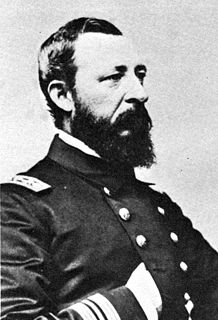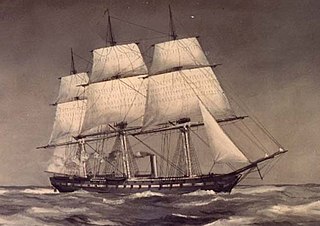
David Glasgow Farragut was a flag officer of the United States Navy during the American Civil War. He was the first rear admiral, vice admiral, and admiral in the United States Navy. He is remembered for his order at the Battle of Mobile Bay usually paraphrased as "Damn the torpedoes, full speed ahead" in U.S. Navy tradition.

USS Minnesota was a wooden steam frigate in the United States Navy. Launched in 1855 and commissioned eighteen months later, the ship served in east Asia for two years before being decommissioned. She was recommissioned at the outbreak of the American Civil War and returned to service as the flagship of the North Atlantic Blockading Squadron.

The Confederate States Marine Corps (CSMC) was a branch of the Confederate States armed forces during the American Civil War. It was established by an act of the Confederate Congress on March 16, 1861. The CSMC's manpower was initially authorized at 45 officers and 944 enlisted men, and was increased on September 24, 1862 to 1,026 enlisted men. The organization of the corps began at Montgomery, Alabama, and was completed at Richmond, Virginia, when the capital of the Confederate States was moved to that location. The CSMC headquarters and main training facilities remained in Richmond, Virginia throughout the war, located at Camp Beall on Drewry's Bluff and at the Gosport Shipyard in Portsmouth, Virginia. The last CSMC unit surrendered to the United States on April 9, 1865, with the Confederacy itself capitulating to the U.S. a month later.

Daniel Ammen was a U.S. naval officer during the American Civil War and the postbellum period, as well as a prolific author. His last assignment in the Navy was Chief of the Bureau of Navigation.

USS Hartford, a sloop-of-war, steamer, was the first ship of the United States Navy named for Hartford, the capital of Connecticut. Hartford served in several prominent campaigns in the American Civil War as the flagship of David G. Farragut, most notably the Battle of Mobile Bay in 1864. She survived until 1956, when she sank awaiting restoration at Norfolk, Virginia.

Charles Williamson Flusser was an officer in the United States Navy during the American Civil War.

Peter Umstead Murphey was a former officer of the United States Navy who joined the Confederate States Navy during the American Civil War.
USS Plymouth was a sloop-of-war constructed and commissioned just prior to the Mexican–American War. She was heavily gunned, and traveled to Japan as part of Commodore Matthew C. Perry's effort to force Japan to open her ports to international trade. She also served in European and Caribbean waters and, later in her career, she was used to train midshipmen.
The Battle of Sewell's Point was an inconclusive exchange of cannon fire between the Union gunboat USS Monticello, supported by the USS Thomas Freeborn, and Confederate batteries on Sewell's Point that took place on May 18, 19 and 21, 1861, in Norfolk County, Virginia in the early days of the American Civil War. Little damage was done to either side. By the end of April 1861, USS Cumberland and a small number of supporting ships were enforcing the Union blockade of the southeastern Virginia ports at the southern end of the Chesapeake Bay and had captured several ships which attempted to pass the blockade. USS Monticello's bombardment of the Sewell's Point battery was one of the earliest Union Navy actions against Confederate forces during the Civil War. While it has been suggested by some sources that the Monticello's action may have been the first gunfire by the Union Navy during the Civil War, a brief exchange of cannon fire between the U.S. gunboat USS Yankee and shore batteries manned by Virginia volunteer forces which had not yet been incorporated into the Confederate States Army at Gloucester Point, Virginia on the York River occurred on May 7, 1861.

USS Wabash was a steam screw frigate of the United States Navy that served during the American Civil War. She was based on the same plans as Colorado. Post-war she continued to serve her country in European operations and eventually served as a barracks ship in Boston, Massachusetts, and was sold in 1912.
USS Germantown was a United States Navy sloop-of-war in commission for various periods between 1847 and 1860. She saw service in the Mexican–American War in 1847–1848 and during peacetime operated in the Caribbean, in the Atlantic Ocean off Africa and South America, and in East Asia. Scuttled at the outbreak of the American Civil War in 1861, she was captured and refloated by the Confederate States of America and placed in service with the Confederate States Navy as the floating battery CSS Germantown before again being scuttled in 1862.

USS Richmond was a wooden steam sloop in the United States Navy during the American Civil War.

The first USS Seminole was a steam sloop-of-war in the United States Navy during the American Civil War.

The first USS Pocahontas, a screw steamer built at Medford, Massachusetts in 1852 as City of Boston, and purchased by the Navy at Boston, Massachusetts on 20 March 1855, was the first United States Navy ship to be named for Pocahontas, the Algonquian wife of Virginia colonist John Rolfe. She was originally commissioned as USS Despatch – the second U.S. Navy ship of that name – on 17 January 1856, with Lieutenant T. M. Crossan in command, and was recommissioned and renamed in 1860, seeing action in the American Civil War. As Pocahontas, one of her junior officers was Alfred Thayer Mahan, who would later achieve international fame as a military writer and theorist of naval power.
USS Yankee (1861) was a steam-powered side-wheel tugboat acquired by the Union Navy just prior to the outbreak of the American Civil War.

The first USS Dawn was a steam-operated vessel acquired by the Union Navy during the American Civil War. She was used by the Navy to patrol navigable waterways of the Confederacy to prevent the South from trading with other countries.

Hispanics in the American Civil War fought on both the Union and Confederate sides of the conflict. Not all the Hispanics who fought in the American Civil War were "Hispanic-Americans", in other words citizens of the United States. Many of them were Spanish subjects or nationals from countries in the Caribbean, Central and South America. Some were born in a US Territory and therefore did not have the right to US Citizenship. It is estimated that approximately 3,500 Hispanics, mostly Mexican-Americans, Puerto Ricans and Cubans living in the United States joined the war: 2,500 for the Confederacy and 1,000 for the Union. This number increased to 10,000 by the end of the war.

Joseph P. Fyffe was a Rear Admiral in the United States Navy. He saw service in both the Mexican War and the American Civil War.

Rear Admiral George H. Cooper was an officer in the United States Navy. During his long naval career, he served on the African Slave Trade Patrol, and fought in the Second Seminole War, the Mexican War, the American Civil War, and the Korean Expedition, and rose to command of the North Atlantic Squadron.

Francis John Higginson was an officer in the United States Navy during the American Civil War and Spanish–American War. He rose to the rank of rear admiral and was the last commander-in-chief of the North Atlantic Squadron and first commander-in-chief of the North Atlantic Fleet.















